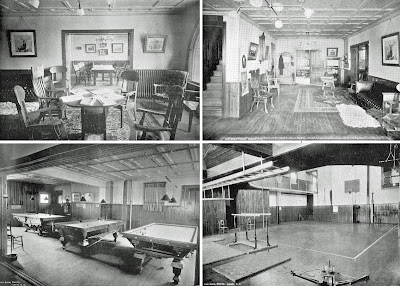by Erin Doane, Curator
In the 1890s, the bicycle craze swept the nation. There
were some 9,000 bicycles in Elmira alone in 1898. With a population of around
35,000, that was roughly one bicycle for every four people. Bicycles were
relatively inexpensive, easy to operate, and a lot of fun to ride. It’s no
wonder that they became so widely popular. The Kanaweola Bicycle Club was
formed as a social club for bicycling enthusiasts in Elmira.
 |
| Kanaweola
Bicycle Club at the Elmira Reformatory, July 4, 1895 |
In the beginning, the club’s activities were
focused on cycling, as one would expect. Members would go on tours and daytrips
to places like Watkins Glen, Corning, Big Flats, Pine City, and Millport. The
club also hosted bicycle races where cyclists from around the region competed
for prizes including sweaters and fancy hosiery. A race meet on Decoration Day
in 1891 began with a parade of decorated bicycles that started at the Kanaweola
clubhouse on West Gray Street. All wheelmen were invited to participate.
 |
Kanaweola Club on an outing to Painted Post, June 6, 1897
While I’m not sure if the club ever accepted women as
official
members, they participated in club activities.
|
The clubhouse at 214 West Gray Street had a
shooting gallery in the basement and pool and billiard tables on the second
floor. In 1899, the club decided to move their clubhouse to rooms in the
Y.M.C.A. building on E. Market Street. That same year, they amended their
constitution to limit membership to 300. They also raised membership dues by $1
and set dues for foreign members at $6 a year. In 1900, the club moved into the
Realty Building on E. Market Street. The new clubhouse included a parlor,
reading room, billiard room, and gymnasium.
 |
Interior
views of the Kanaweola Clubhouse, 1901
Clockwise
from top left: parlor looking toward reading room;
parlor
looking toward billiard room; gymnasium; billiard room
|
While cycling was a major activity for the club,
in the winter, it was difficult and unpleasant to go on bike outings. To stay
active, the club hosted weekly get-togethers. The newspaper is filled with
announcements for “smokers” at the Kanaweola clubhouse. At a smoker “every
member who is so inclined will bring his pipe and cigars will be found at the
clubhouse.” On December 5, 1895, the club hosted a “tramp” smoker at which the
club members were expected to dress in tramp or farmer costumes. Prizes were
awarded for best makeup. In 1900, they even hosted a “ladies’ smoker.”
 |
| Kanaweola
Bicycle Club “tramp” smoker, c. 1895 |
In the late 1890s, the club got involved in other
sports beyond cycling. They fielded a football team, a basketball team, and an
indoor baseball team. In 1901, they held a bowling tourney, and in 1907 boxing
became very popular at the club. In fact, it was boxing that brought about the
dissolution of the Kanaweola Bicycle Club. New leadership in the club decided
to construct a stage and wresting ring in the gymnasium at the clubhouse and
promoted professional boxing matches in the space. That made it impossible for
members to use the gym for any other sports like basketball, handball, or
wrestling. Poor decisions like that led to financial troubles which led to the
sheriff closing the clubhouse and auctioning off the property in 1908.
 |
| Star-Gazette headline,
March 11, 1908 |
One last bit of information: “Kanaweola” is said
to mean “head on a pole.” It was the name of a Native American village at the
junction of the Newtown Creek and the Chemung River. Legend has it that in the
18th century, a tribal chief was found guilty of treason and his
head was placed on a pole there to serve as a warning to others.
 |
| Kanaweola Bicycle Club at Fitch’s Bridge, 1890s |






Very interesting hard to imagine riding one of those old heavy bikes to Watkins Glen. Catchy name for the club Kanaweola and the story behind it.
ReplyDelete